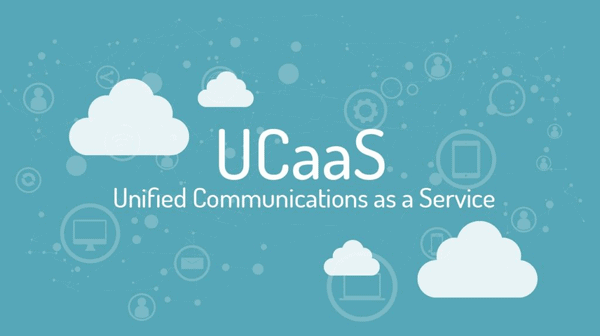Employees of a firm may interact from anywhere and at any time using a basic internet connection and a linked device, thanks to the proliferation and democratization of linked tools (smartphones, tablets, or computers). Internal and external communication modalities have also changed dramatically, providing a variety of instruments for exchanging information among colleagues as well as with consumers and suppliers.
If the solutions supplied to businesses are aimed at meeting their various expectations and special demands, the proliferation of tools might have a detrimental influence on team productivity and cause additional expenditures for IT departments. This is why certain telecommunications firms have created UCaaS solutions.
For a few years now, businesses including contact centers have relied heavily on Cloud technologies. While apps are becoming more cloud-based, corporate telephony has also shifted to UCaaS or Unified communication as a service. A telephone resource consumption model that is well suited to the needs of cooperation.
Hence the questions: What is exactly UCaaS? What are its advantages? What does the future hold for such technology? We answer all these questions and more in our article.
What exactly is a UCaaS?
UCaaS is an acronym that stands for “Unified Communications on Demand.” It is a unified communications solution, or all-in-one solution, that integrates a cloud phone system with collaboration, messaging, and video conferencing technologies into a single system.
Businesses may utilize UCaaS to streamline operations, enhance flexibility and cooperation, increase user support, and lower communication costs. This Cloud-based solution is accessible from a supplier who handles all technical and infrastructural concerns. As it allows users to subscribe to a variety of programs and functions and are accessible through the Internet or a private network.
Functions & Capabilities
The goal of UCaaS functions is to consolidate several communication and collaboration technologies into a single platform. These functions include:
- voice and telephony, including mobile (and VoIP),
- meeting solutions such as audio conferencing, video conferencing, and web conferencing,
- unified messaging allowing voice messages to be received via email instant messaging (IM),
- attendance management,
- online meetings,
- desktop and browser clients application
Some UCaaS providers additionally include integrated contact center features such as:
- automated phone answering,
- interactive voice response,
- call routing,
- integration with customer relationship management tools (CRM and ticketing/customer support software).
A brief history
 UCaaS originated in the early 2010s as a result of the advancement of cloud computing technology.
UCaaS originated in the early 2010s as a result of the advancement of cloud computing technology.
Historically, businesses purchased and installed their own communications infrastructure on their premises. This was by far the most cost-effective method, as using a PBX eliminated the need for individual phone lines for each employee. Furthermore, it provided enterprises with extra services like a switchboard, phone transfer, conference calls, and so on.
The telecommunications business has evolved to a service provider model with the advent of VoIP and data center virtualization. Cloud telephony solutions are becoming increasingly popular since they are easier to use and more adaptable than on-premise PBXs. The most comprehensive ones include unified messaging, fixed-mobile convergence, and a slew of additional features: this is the start of “Unified Communications as a Service” solutions.
The UCaaS industry, which debuted less than a decade ago, is already fully operational. The worldwide UCaaS market is predicted to be valued at $79.3 billion by 2024, thanks to increasing usage, innovative technologies, and new reseller models.
What is the distinction between VoIP and UCaaS?
A VoIP system normally just provides voice services, incoming and outbound calls, and reports that are more or less particular. A VoIP solution incorporated into a UCaaS system is a critical component of a multi-channel platform that significantly improves corporate communications by enabling IP connections (Internet Protocol).
While VoIP is a single mode of communication, UCaaS is multi-modal: web conferencing, chat, video conferencing, status display, screen sharing, handshake support, connection with CRM and third-party applications, CTI, and, of course, VoIP and WebRTC to power the audio. As a result, we may term it a “true revolution in the communications sector.”
Typical Functions of VoIP
VoIP is a digital telephone service that transports and delivers conversations over the Internet. You can make and receive calls from your Internet connection using a telephone, as is common in most traditional workplaces, or by using a telephony software program (softphone). Calls may be made using a headset with a desktop, laptop, or smartphone in the same manner as they would with a traditional phone.
VoIP systems offer many of the same functions as traditional phone systems, as well as access to more sophisticated choices. VoIP, for example, allows you to receive and listen to voice communications as well as track the origin of calls using caller ID. If no one is accessible, calls can be redirected to other colleagues’ extensions. Other VoIP capabilities include interactive voice servers, automated assistants, call waiting, call reporting, call monitoring, call recording and transcription, conference calls with external access and mobile application call portability.
UCaaS Completes the VoIP
The first restriction of using a VoIP-only solution is the lack of features such as video conferencing. You may arrange individual video conversations and multi-user video conferences with collaboration features by switching to a UCaaS provider. This may not appear to be a necessity for small businesses, but when the firm expands or has several national or international offices, video conversations quickly become a demand. You may have meetings with hundreds of people, share your screen with them, and even exchange and receive external files with all or any of the video conference participants using video conferencing and VoIP.
You may also chat and send text messages to your colleagues in the office or on the road using UCaaS technologies. This particularly applies to contact centers as It enables team agents to discuss easily discuss subjects using instant messaging rather than email.
There are two architectural models for UCaaS
 UCaaS is available in two architectural models: single-tenant and multi-tenant.
UCaaS is available in two architectural models: single-tenant and multi-tenant.
- Single-tenant: Customers that choose single-tenant solutions receive their own exclusive and customized software platform that interfaces with local applications. Because your company’s data is totally independent of the cloud provider’s other customers, this approach is far safer and more trustworthy. Any issues with the instances of other customers have no bearing on your own software platform.
- Multi-tenant: Customers in a multi-tenant system, on the other hand, share a shared software platform. These solutions are often less expensive since they are less adaptable and versatile than single-tenant systems. The platform is housed in the data center of the UCaaS provider, which also conducts software upgrades.
- Special cases: In some circumstances, contact centers might choose a hybrid architecture, maintaining parts of their UC infrastructure locally while storing other apps in the cloud for security and simplicity of management. As a result, some businesses are gradually phasing out older phone systems or other local solutions before transitioning totally to the cloud.
What Are The Advantages of UCaaS Solution for Contact Centers?
- Workplace mobility and fluidity: With the increased usage of telecommuting and mobile working, UC apps must enable users wherever they work. UCaaS services enable users to call, chat, video conference, or begin online meetings from any computer, tablet, or smartphone, regardless of location. These solutions cater to remote and mobile workers.
- Solution Adaptability: UCaaS systems are well-known for their scalability and flexibility in critical business operations. To better meet the demands of the client, adding or deleting user accounts is as simple as clicking a button in the administrative interface. The platform is simple to manage, and use indications may be tracked using a tracking interface.
- Cost-efficient: UCaaS solutions combine many corporate communication building components. Customers can save money on acquiring additional features and subscribing to various applications as a result of this. Moving from an on-premise system to a software-based solution minimizes hardware and telephone expenses, as well as maintenance expenses. A UCaaS provider is responsible for handling security updates and patches, as well as responding to back-end concerns.
- Consistent user experience: The “unified” part of UCaaS provides consumers with a uniform experience across tools and apps. It also implies having a single point of contact for troubleshooting through the UCaaS provider. Similarly, this consistent experience across multiple technologies can help the consumer experience. UCaaS solutions can enable omnichannel communication or augment core customer services with artificial intelligence analytics.
- Advanced capacities for collaboration: UCaaS delivers enhanced collaboration technology to consumers by interconnecting various apps inside UCaaS platforms and integrating them with other business platforms. Business tools connect with one another, allowing for better flexibility and information exchange within divisions of the same organization.
- Improved information access: UCaaS enables businesses to acquire more insights by gaining access to massive volumes of data in the cloud, hence enhancing employee efficiency. All client information is centralized and available to all workers. This facilitates the use of analytical tools to make more informed judgments. According to studies, installing a cloud unified communications system in a business may reduce customer support response times by up to 20%.
- Connectivity to other business software: They integrate with other business tools that are necessary for the contact center, such as CRM, support desks, and so on, in addition to the functionality currently included in UCaaS platforms. These linkages facilitate agents’ work and boost their productivity.
- APIs for more adaptability: Application programming interfaces (APIs) are progressively being added to the basic functionality of UCaaS providers. Customers may incorporate cloud communication features into their work tools by utilizing on-demand communication platform (CPaaS) capabilities and APIs.
- Opportunities for innovation and customization: Using UCaaS cloud solutions lets you customize your solution and simply integrate new technology and innovation possibilities into your organization. You should be able to effortlessly integrate anything from 5G to the Internet of Things if you collaborate with the correct provider.
UCaaS vs CCaaS, what are the differences?
 The benefits of cloud-based phone systems and communication technologies are so numerous and versatile, that it is becoming easy to confuse these various solutions. Contact centers nowadays have many alternatives for digital solutions, and the debate over UCaaS and CCaaS is one of the trending topics in contact center software solutions. Here’s a simple breakdown of these solutions:
The benefits of cloud-based phone systems and communication technologies are so numerous and versatile, that it is becoming easy to confuse these various solutions. Contact centers nowadays have many alternatives for digital solutions, and the debate over UCaaS and CCaaS is one of the trending topics in contact center software solutions. Here’s a simple breakdown of these solutions:
| UCaaS | Similarities | CCaaS |
|---|---|---|
| VoIP technology | Cloud-based technologies | Omnichannel Solution |
| Email and SMS messaging | Installation is quick and simple, compared to typical on-premises solutions | Artificial Intelligence (AI) Technology |
| Social Media Messaging | Easy access to many communication channels | International and Local Numbers |
| Mobile App | Increased agent productivity as a result of automation | IVR |
| Audio and Video meetings | Scalability, upgradeability, and downgrading | Call Routing |
| Live Chat | Exceptional dependability and security | Advanced Reporting and Analytics |
| Screen Sharing | Tools for advanced reporting and analysis | Various Customization Options |
UCaaS: the next-generation technology contact centers?
Being interested in UCaaS solutions is, above all, addressing the issue of a company’s digital transformation. UCaaS technology assists company operations both outside by optimizing its customer experience (CX) and internally by optimizing its employee experience (EX).
To provide an analogy, the options provided by UCaaS solutions to employees are based on the same logic of efficiency and productivity as the omnichannel logic that is already in use for contact center agents. A single, frequently customized interface lets the user get an overview of his exchanges, independent of channel or kind of material, and optimize his interactions.
A significant tendency toward functional integration and interoperability
The capacity of UCaaS solutions to integrate or interoperate with the company’s application ecosystem is also an important selection consideration.
A UCaaS solution looks to be a tool for gathering material and supporting decision making, whether through a library of official connectors, an SDK, or the supply of APIs.
Publishers are rushing to construct connections and boast about the breadth of their connector libraries. In Fact, the evolution of traditional enterprise instant messaging towards a ChatOps-like UCaaS approach is increasing greatly. ChatOps is a communication-centric collaboration method that connects people, resources, content, and automation in a single, transparent workflow and is the flagship of players.
What’s fascinating about this expansion of interoperability/application integration is that the company’s communication system can take on a new dimension in which voice is ultimately just one vector among many: for example, opening up to IoT connectors will profoundly evolve the capabilities of a contact center dedicated to the health sector.
Monitoring is becoming increasingly important
The growing usage of UCaaS solutions has highlighted the need for tools to set up and monitor them. While videoconferencing may have a few transitory flaws (complicated access ergonomics, unreliable bandwidth, poor sound quality), its rapid introduction and frequent use have emphasized the need for stronger supervision and control.
First and foremost, on the service quality, including tools for regulating audio and video quality: synchronous tools, directly related to bandwidth management on the business network as well as on the links (private or not) between the user sites and the cloud server.
Then there’s the security issue: companies’ efforts to deliver end-to-end encryption capabilities have shown the misuse of marketing language as well as the limitations that severe security may impose on a solution’s usefulness.
In addition, the complexity of VoIP / UCaaS designs increases the danger of a breach and necessitates the deployment of fraud detection technologies or real-time assaults on systems.
Finally, administrators and project managers must keep track of how new technologies are being used by employees. A UCaaS project’s return on investment is directly conditioned by changes in behavior and usage, which specialist technologies can now synthesize in the form of KPIs.
A data vision that has become necessary
 We have reached a data-abundant era. UCaaS systems are no exception, with many branches inside the company information system capable of tracking a wide variety of characteristics.
We have reached a data-abundant era. UCaaS systems are no exception, with many branches inside the company information system capable of tracking a wide variety of characteristics.
A UCaaS and digital transformation project cannot be implemented without a strategic vision of company data. Data silos must be broken down as part of the promised advantages.
New software tools are becoming more accessible. They are known as Collaboration Performance Management (CPM) or EXP (Employees eXperience Platform), and they can target a single point of supervision or a larger perimeter. They can also cause conflicts when applied to individual actions. As an example; Microsoft’s productivity score measuring tool did in 2020 when it was perceived as being a tool for monitoring staff.
Is UCaaS an evolution or a revolution?
The UCaaS business certainly has a sneaky dynamic: depending on the source, the worldwide market represented between 10% and 20% of the UCC market in 2019.
According to Gartner, a growth rate of 20 percent to 30 percent every year would bring its penetration to 35 percent by 2023. In terms of value, this market would be valued at around $30 billion in 2021, $80 billion in 2024, and $170 billion in 2027.
Even while these data should be interpreted with caution (the definition of UCaaS differs by source), it appears that the main question is not if UCaaS will take over, but when and at what rate.
Acceptance barriers are being reduced, and the Covid-19 influence has hastened the adoption of new applications by three to seven years. However, there are still limits that play a role in the adoption of 100 percent cloud computing, such as control over the degree of security, SLA of the connection utilized, data residency, and change management control, to mention a few.
To negotiate these new technology and use settings with ease, it is critical to surround yourself with specialists in the sector, such as specialist integrators.
Despite this, SMBs and IT firms favor soft methods for the time being: hybrids, private clouds, CPaaS, virtualization. According to an Eastern Management Group survey, UCaaS accounted for just 7% of purchases for organizations with more than 1000 employees. This rate would be 13% in 2024, significantly lower than the rate reported for VSEs and networked enterprises (franchises) that are now focused on pure cloud UCaaS solutions.
The UCaaS paradigm has a promising future. Its distinct advantages in terms of utilization for both employees and administrators will be bolstered by the granularity provided by CPaaS solutions. These solutions provide a smooth development by expanding an existing onsite system by adding only the functional modules required by the firm in SaaS mode. UCaaS technologies will also find a strong ally in the introduction of 5G to enhance cloud use.
NobelBiz, The All-in-one Solution for All Contact Centers
At NobelBiz, We acknowledge that your clients value the ability to reach your clients across different channels seamlessly. Therefore, we visualize each necessary improvement needed with an omnichannel customer experience in mind.
Our goal of NobelBiz is to make sure that our clients are always one step ahead of the times. That is why our Cloud Contact Center Solution NobelBiz OMNI+ creates more successful customer interactions while increasing contact center productivity, without the capital expense and maintenance costs of on-premise-based systems.
Improve Your Customer Experience & Engagement with an all-in-one solution that gives you:
- Social Media Integration: Communicate seamlessly and easily where your customers socialize the most. Voice Calls, Facebook Messenger, Twitter, WhatsApp, Telegram, SMS, Email, Live Chat, and Webchat. All in a single unified dashboard.
- CRM and other API integrations: a high degree of customizability and scalability. We have in our arsenal a great list of CRM and API integrations with the support of our development and engineering teams.
- Capabilities Right Out of the Box: features a lightning-fast implementation. Data transition, actual installation, linking, and integrations will take somewhere around 74 hours.
- Precise Measurements: Leverage the power of data with NobelBiz OMNI+ through a powerful Personalized Reports Engine.
- Fair Workload Monitoring System: Allow managers and owners alike to implement a truly equitable and fair performance bonus system.
- Omnichannel Campaign Setup: creating and coordinating all these campa

Michael McGuire is a contact center industry expert with almost two decades of experience in the space. His experience includes roles as Director of Contact Center Digital Transformation at NobelBiz, and as Director of Operations at FLS Connect, managing multiple call centers. As President of Anomaly Squared and Targeted Metrics, Michael successfully transitioned companies into remote operations and significantly boosted revenues. With a strong background in customer service, leadership, strategic planning, and operations management, Michael excels in driving growth and innovation in the call center space.
Mike is also a proud Board Member for R.E.A.C.H Trade Group, promoting consumer protection and satisfaction and Co-host of the Off Skripted Podcast – a show about Life, Call Centers and everything in between.







